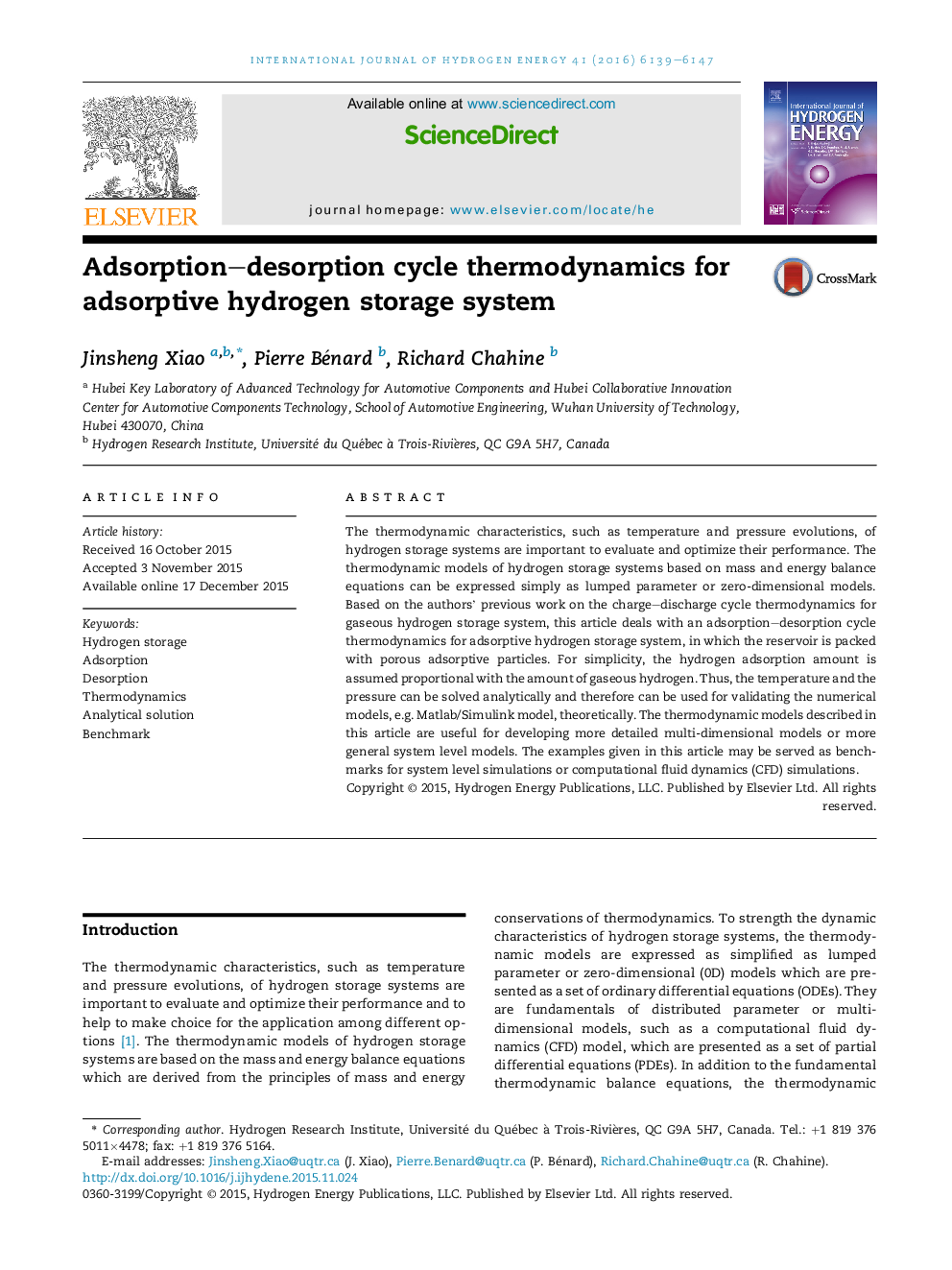| کد مقاله | کد نشریه | سال انتشار | مقاله انگلیسی | نسخه تمام متن |
|---|---|---|---|---|
| 1273620 | 1497411 | 2016 | 9 صفحه PDF | دانلود رایگان |
کلمات کلیدی
مقدمه
علائم و اختصارات
معادلات موازنه انرژی و جرم
دمای جریان ورودی/خروجی ثابت در فرایند شارژ و دشارژ
دمای ورودی/خروجی متغیر در فرایند شارژ و دشارژ
جدول1. خلاصهای از معادلات و راه حلهای ترمودینامیکی در چرخه جذب-واجذب.
جدول2. مقایسه بین سیستمهای ذخیره سازی هیدروژن، فشرده سازی و جذب.
جدول 3. پارامترهای برای راه حلهای معادلات ترمودینامیکی در چرخه جذب-واجذب.
جدول4. مقایسه سه مورد با نسبتهای مختلف جرم جذب شده به جرم گازی.
شکل1. مدل متلب/سمیولینک با توابع متلب از راه حلهای تحلیلی.
شکل 2. موازنه انرژی و راه حلهای تحلیلی برای مورد : (a) نرخ آنتالپی جریان ورودی H (کیلو وات)، نرخ گرمای جریان ورودی Qf (کیلو وات) و نرخ جذب حرارت تولیدی Qa (کیلووات)، از بالا به پایین و(b) راه حلهای تحلیلی از جرم m (کیلوگرم)، فشار p (مگا پاسکال) و دمای T (کلوین)، از بالا به پایین.
فشار محلول در چرخه شارژ ودشارژ
استفاده از راه حلهای تحلیلی برای اعتبارسنجی مدل متلب/سمیولینک
شکل 3. موازنه انرژی و راه حلهای تحلیلی برای مورد : (a) نرخ آنتالپی جریان ورودی H (کیلو وات)، نرخ گرمای جریان ورودی Qf (کیلو وات) و نرخ جذب حرارت تولیدی Qa (کیلووات)، از بالا به پایین و(b) راه حلهای تحلیلی از جرم m (کیلوگرم)، فشار p (مگا پاسکال) و دمای T (کلوین)، از بالا به پایین.
نتایج
شکل 4. موازنه انرژی و راه حلهای تحلیلی برای مورد : (a) نرخ آنتالپی جریان ورودی H (کیلو وات)، نرخ گرمای جریان ورودی Qf (کیلو وات) و نرخ جذب حرارت تولیدی Qa (کیلووات)، از بالا به پایین و(b) راه حلهای تحلیلی از جرم m (کیلوگرم)، فشار p (مگا پاسکال) و دمای T (کلوین)، از بالا به پایین.
• A uniform thermodynamic model expresses all processes of adsorption–desorption cycle.
• The model is solved analytically under constant/variable inlet/outlet temperatures.
• Concepts of characteristic time and adsorption contributed temperature are proposed.
• Hydrogen adsorption amount is assumed proportional with gaseous one for simplicity.
• The solution provides good benchmarks for multi-dimensional or system level models.
The thermodynamic characteristics, such as temperature and pressure evolutions, of hydrogen storage systems are important to evaluate and optimize their performance. The thermodynamic models of hydrogen storage systems based on mass and energy balance equations can be expressed simply as lumped parameter or zero-dimensional models. Based on the authors’ previous work on the charge–discharge cycle thermodynamics for gaseous hydrogen storage system, this article deals with an adsorption–desorption cycle thermodynamics for adsorptive hydrogen storage system, in which the reservoir is packed with porous adsorptive particles. For simplicity, the hydrogen adsorption amount is assumed proportional with the amount of gaseous hydrogen. Thus, the temperature and the pressure can be solved analytically and therefore can be used for validating the numerical models, e.g. Matlab/Simulink model, theoretically. The thermodynamic models described in this article are useful for developing more detailed multi-dimensional models or more general system level models. The examples given in this article may be served as benchmarks for system level simulations or computational fluid dynamics (CFD) simulations.
Journal: International Journal of Hydrogen Energy - Volume 41, Issue 14, 20 April 2016, Pages 6139–6147
